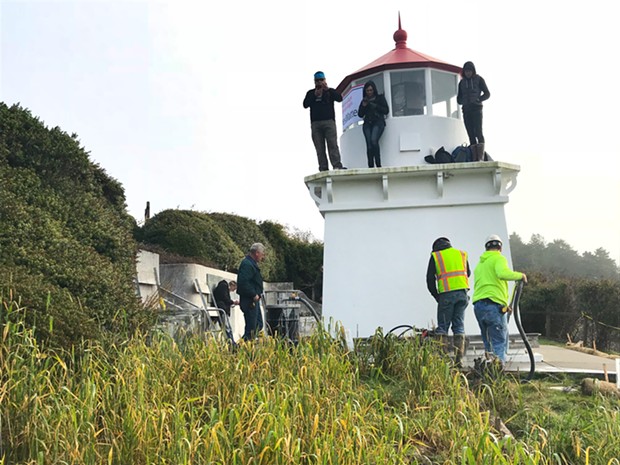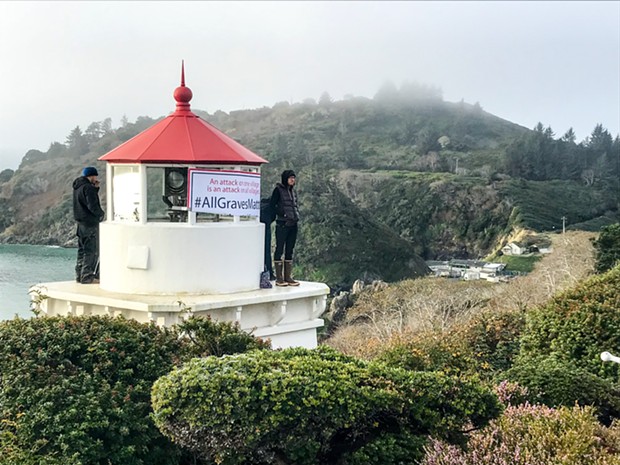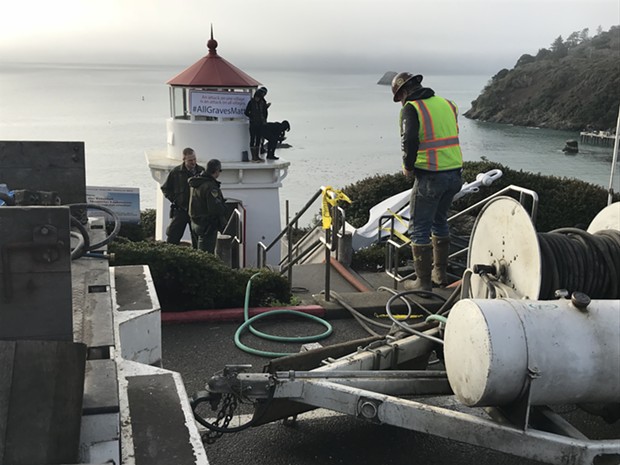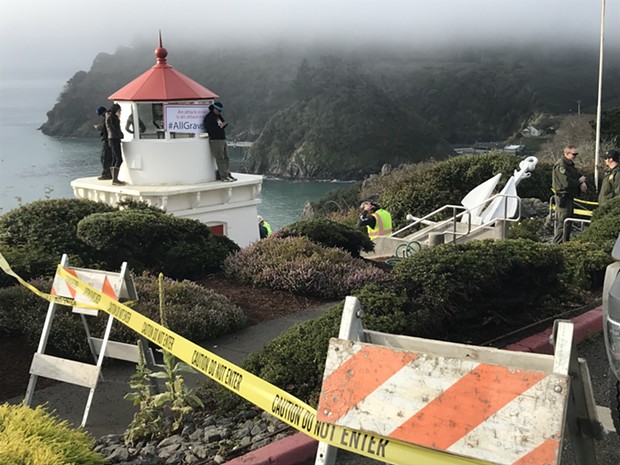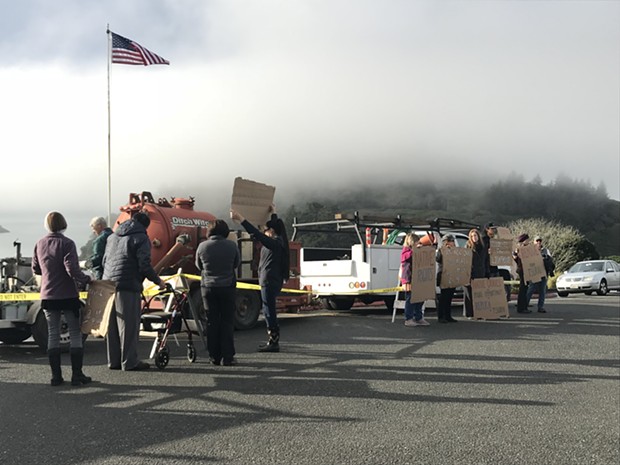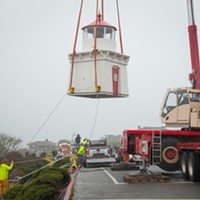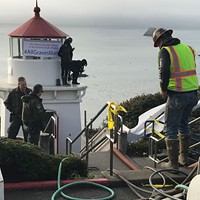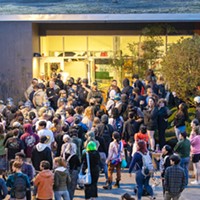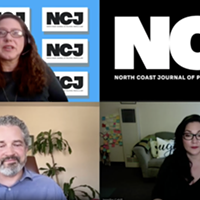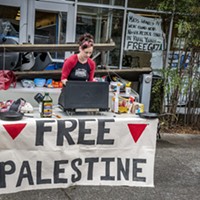Thursday, December 28, 2017
Protesters Try to Block Lighthouse Move
Posted By Thadeus Greenson @ThadeusGreenson on Thu, Dec 28, 2017 at 10:27 AM
A handful of protesters scaled the Trinidad Memorial Lighthouse before daybreak this morning in an effort to block its scheduled move next week.
The historic lighthouse, which is on unsteady ground in the midst of an active landslide and in danger of tumbling to the rocky shoreline below, has long been a point of contention for some local tribes. Earlier this month, the Trinidad Civic Club, which owns the lighthouse, announced emergency plans to move the lighthouse about 20 feet to the east onto firmer ground.
But the lighthouse sits on a traditional Yurok village site, Tsurai, which includes a cemetery, and the Yurok Tribe issued a scathing press release earlier this month likening the lighthouse to a Confederate monument and noting that the cemetery it sits atop is occupied in part by Yuroks killed by white settlers.
Lucas Garcia, one of the protesters currently occupying the lighthouse, says native people’s voices were ignored or cut out of discussions about what to do about the failing lighthouse.
“I’m actually a direct descendent from the village of Tsurai and I’m here to protect what we have left and to protect my ancestors who are buried right below where the lighthouse is,” Garcia says. “This temporary solution isn’t a solution. This move is only going to further harm the cultural resources present at the site.”
Currently, the protesters say a construction crew beneath them is continuing to prepare the lighthouse to be moved by crane to the new site next week as more than a half dozen Humboldt County Sheriff’s Office deputies stand by. Sheriff William Honsal says he has no plans to intervene or disturb the protest at this point.
“We’re there monitoring the situation right now,” he says. “They’re peacefully protesting. We’re talking to them to make sure it stays peaceful. As long as it stays peaceful, we’re not going to interfere.”
Trinidad Civic Club Chair Patti Fleschner says the move is an attempt to save both the lighthouse and the village site below. "This is an attempt to preserve and protect these two important historic Trinidad sites," she says. In an interview with the Lost Coast Outpost earlier this month, she said the lighthouse, which includes a monument to 238 people buried at sea, is "iconic for the whole county" and is a "sacred place, just as the ancient Tsurai Village is a sacred place."
Stanton Wood, one of the protesters who used to live in Trinidad and says he’s followed the situation closely, says they want to see the project put on hold so all interested parties can return to the negotiating table to find a solution that addresses tribal concerns. The protest is being streamed on Facebook live here, and Garcia urges those concerned about the planned move to get involved.
“Just come out and show support,” he says. “All we’re asking for is a dialogue for our people to be heard.”
For some background on the issue, see dueling press releases sent out by the Yurok Tribe and the Trinidad Rancheria copied below these pictures from local photographer Mark McKenna.
From the Yurok Tribe:
The historic lighthouse, which is on unsteady ground in the midst of an active landslide and in danger of tumbling to the rocky shoreline below, has long been a point of contention for some local tribes. Earlier this month, the Trinidad Civic Club, which owns the lighthouse, announced emergency plans to move the lighthouse about 20 feet to the east onto firmer ground.
But the lighthouse sits on a traditional Yurok village site, Tsurai, which includes a cemetery, and the Yurok Tribe issued a scathing press release earlier this month likening the lighthouse to a Confederate monument and noting that the cemetery it sits atop is occupied in part by Yuroks killed by white settlers.
Lucas Garcia, one of the protesters currently occupying the lighthouse, says native people’s voices were ignored or cut out of discussions about what to do about the failing lighthouse.
“I’m actually a direct descendent from the village of Tsurai and I’m here to protect what we have left and to protect my ancestors who are buried right below where the lighthouse is,” Garcia says. “This temporary solution isn’t a solution. This move is only going to further harm the cultural resources present at the site.”
Currently, the protesters say a construction crew beneath them is continuing to prepare the lighthouse to be moved by crane to the new site next week as more than a half dozen Humboldt County Sheriff’s Office deputies stand by. Sheriff William Honsal says he has no plans to intervene or disturb the protest at this point.
“We’re there monitoring the situation right now,” he says. “They’re peacefully protesting. We’re talking to them to make sure it stays peaceful. As long as it stays peaceful, we’re not going to interfere.”
Trinidad Civic Club Chair Patti Fleschner says the move is an attempt to save both the lighthouse and the village site below. "This is an attempt to preserve and protect these two important historic Trinidad sites," she says. In an interview with the Lost Coast Outpost earlier this month, she said the lighthouse, which includes a monument to 238 people buried at sea, is "iconic for the whole county" and is a "sacred place, just as the ancient Tsurai Village is a sacred place."
Stanton Wood, one of the protesters who used to live in Trinidad and says he’s followed the situation closely, says they want to see the project put on hold so all interested parties can return to the negotiating table to find a solution that addresses tribal concerns. The protest is being streamed on Facebook live here, and Garcia urges those concerned about the planned move to get involved.
“Just come out and show support,” he says. “All we’re asking for is a dialogue for our people to be heard.”
For some background on the issue, see dueling press releases sent out by the Yurok Tribe and the Trinidad Rancheria copied below these pictures from local photographer Mark McKenna.
From the Yurok Tribe:
The Yurok Tribe is deeply disappointed with a premature decision to move the Trinidad Memorial Lighthouse, prior to the completion of a formal consultation process between interested parties.From the Rancheria:
“To move the memorial in the midst of the consultation process, under the guise of an ‘emergency,’ is disgraceful and disrespectful,” said Rosie Clayburn, the Director of the Yurok Tribe’s Cultural Division. “We have been working, in good faith, with the City of Trinidad and Trinidad Civic Club to relocate the memorial to a place where it would not disturb our ancestors and where it would not be in danger from falling.”
‘After the memorial lighthouse began to slip in the winter of 2016, the Yurok Tribe contacted the City of Trinidad and the Trinidad Civic Club to initiate an official dialogue regarding the relocation of the monument to an area that was acceptable to all. The lighthouse replica sits atop a traditional Yurok village site, containing a large cemetery, which is occupied, in part, by Yuroks who were killed by white settlers during the Gold Rush. The Tribe hoped that the structure could be moved to a destination that no longer had the potential to disturb the relatives of many local Yurok families.
Chue-rey, also spelled Tsurai, is one of the largest Yurok village sites. The adjacent natural harbor and formerly abundant natural resources enabled the Tribe to develop a thriving community on the bluffs overlooking the ocean. The protected bay was also used a primary port during the Gold Rush, a horrific time in the Tribe’s history, when miners murdered untold numbers of Yuroks in Trinidad and along the Klamath River. Prior to the 1850s, the Yurok people had very little contact with non-Indians.
“For Yuroks, the Trinidad Memorial Lighthouse is a monument to this tragic era. We feel like it is no different than the statues created to honor confederate soldiers in the south,” said Frankie Myers, the Yurok Tribal Heritage Preservation Officer. “What we’re asking is for the city and Civic Club to give the same respect to our ancestors as they give to the families of the 238 people who were buried at sea.”
The accumulative impact of the Civic Club’s projects in proximity to the monument destabilized the bluff and caused the Memorial Lighthouse to slide last winter. The Yurok Tribe believes that the City of Trinidad and Trinidad Civic Club claimed that the memorial was in imminent danger of falling in order to push the project forward, because both knew the Tribe and Tsurai Ancestral Society did not support the move.
“The California Coastal Conservancy did not support the approval of an emergency permit, nor the proposed placement of the Memorial Lighthouse. They contested it along with attorney Ralph Faust.” said Sarah Lindgren-Akana, the secretary for the Tsurai Ancestral Society.
The new location for the lighthouse, just 12 feet from where it formerly sat, still has the potential to fail, according to geological reports associated with the project.
“If the new location slips toward the sea, it will take out the cemetery, most of the village site and the Axel Lindgren Memorial Trail, a path our people have used since time immemorial,” said Clayburn, the Director of the Yurok Cultural Division. “Even though the city and the Civic Club did not select the original placement of the memorial, they are responsible for what happens now.”
The Yurok Tribe is the largest Tribe in California with more than 6,000 members. The Tribe’s ancestral territory comprises 7.5 percent of the California coastline, spanning from the Little River to the south and Damnation Creek to the north. The eastern boundary is the Klamath River’s confluence with the Trinity River. The Tribe is a leader in natural resource management, fisheries restoration and cultural protection.
December 27, 2017
Trinidad Rancheria Responds To Trinidad Memorial Lighthouse Issues
Recently, the Cher-ae Indian Community of the Trinidad Rancheria (Trinidad Rancheria), a Federally Recognized Tribe, has been attacked politically and culturally by the Yurok Tribe and the Tsurai Ancestral Society (TAS). Until this time, the Tribal Council has chosen not to respond to allegations and accusations made by either group. The Trinidad Rancheria has been misrepresented and maligned by the TAS, as well as by members of the Yurok Tribe, their Council and staff. Despite these unjustified accusations and negative attacks, the Trinidad Rancheria is determined to remain faithful to our Vision and Mission Statements.
The Trinidad Rancheria is extremely concerned about the Trinidad Memorial Lighthouse, as well as Trinidad Rancheria lands, the Tsurai Village, the Galindo Street Trail, and the larger Trinidad Community as a whole. We want the community and the public to understand that we do not agree with some aspects of the statements and actions of the Yurok Tribe and the TAS regarding these areas.
To collaboratively come to a successful resolution of the issue of the Memorial Lighthouse, Trinidad Rancheria recommends convening the Civic Club (the owner of the Memorial Lighthouse), and the appropriate governmental entities and stakeholders to develop solutions and create a cooperative body for the Memorial Lighthouse and the surrounding area. An extremely good example of a local cooperative management team is the one formed through the Bureau of Land Management (BLM) Trinidad Head Lighthouse Management Plan. The United States Coast Guard transferred the Trinidad Head Lighthouse to the BLM in May, 2014. The BLM asked the City of Trinidad, The Yurok Tribe, and the Trinidad Rancheria “to participate as Cooperating Agencies (40 CFR 1501.6, 40 CFR 1508.5) to bring special expertise to the development of this management plan.” The BLM model could serve as a tried and true template in resolving the Memorial Lighthouse issues.
On December 7, an emergency permit was issued by the City of Trinidad to begin temporary relocation efforts of the Memorial Lighthouse. The Civic Club contracted with Trinidad Rancheria to provide cultural monitoring services for the project during the week of December 11, and our Tribal Heritage Preservation Officer felt it vital for on-site monitoring. A certified cultural monitor was on site performing her job duties, when several staff of the Yurok Tribe arrived on site and demanded that the Civic Club and the contractor immediately cease work, and directly questioned the Trinidad Rancheria employee as to her qualifications and training as a Cultural Monitor.
Page 2 - Trinidad Rancheria Responds to Trinidad memorial Lighthouse Issues
The Yurok Tribe has repeatedly disputed Trinidad Rancheria’s Cultural Monitors and Tribal Heritage Preservation Officer’s knowledge and qualifications to perform such duties; when in fact, the Trinidad Rancheria and the Yurok Tribe have previously sponsored joint Cultural Monitor Certification Trainings and certified their respective monitors utilizing the identical curriculum. We trained our monitors together in a collaborative effort to protect resources throughout our shared ancestral territory.
In a December 15 statement published in the Lost Coast Outpost, Rosie Clayburn, the Director of the Yurok Tribe Cultural Division, stated “If the new location slips toward the sea, it will take out the cemetery, most of the village site and the Axel Lindgren Memorial Trail, a path our people have used since time immemorial.” As people of Yurok descent and heritage, the Rancheria respects the cultural and historic importance of the Tsurai village and agrees that protection of the village and associated burial sites is of utmost importance. The current project will move the lighthouse 20 feet to the left of the existing location. If the new location slips, it may impact the Tsurai Study Area and therefore a long term strategy should be explored for permanent relocation
In the same article, Frankie Myers, the Yurok Tribal Heritage Preservation Officer likened the Memorial Lighthouse to the Gold Rush era, stating that “For Yuroks, the Trinidad Memorial Lighthouse is a monument to this tragic era. We feel like it is no different than the statues created to honor confederate soldier in the south.” Trinidad Rancheria agrees that the atrocities of the past were a horrific time in the history of all Yurok people, which includes not only the Yurok Tribe but also the Big Lagoon Rancheria, Resighini Rancheria and the Trinidad Rancheria, all tribes of “Historic Yurok Origin.” (Senate Report Number 100-564 at 29 (1988). The Yurok Tribe and the TAS both deny that Trinidad Rancheria Tribal members descend from the village; however family genealogies demonstrate otherwise. Nevertheless, in the spirit of reunification and collaboration, all parties should come together in a peaceful and respectful manner to resolve the issues.
The Tsurai village is located within the historic area or ancestral territory of the Yurok people. The Yurok Tribe in their constitution claims “jurisdiction over ancestral territory,” from the mouth of Wilson Creek near Klamath to Little River. This area includes public, private and tribal lands not under the control or authority of the Yurok Tribe, and the Trinidad Rancheria has 97 acres of trust land in the region. This “ancestral territory” is in reality a common territory shared by all descendents of Yurok People as a whole. The Yurok Tribe is not synonymous with the Yurok people; this is the ancestral homeland of all Federally Recognized Tribes of historic Yurok origin
Page 3 - Trinidad Rancheria Responds to Trinidad memorial Lighthouse Issues.
The Yurok Tribe has been working on Yurok Lands Legislation for several years, sponsored by Congressman Jared Huffman. The Trinidad Rancheria has been working with Congressman Huffman and his staff to recommend revised language in the legislation to specifically state that the Yurok Tribe does not have jurisdiction over ancestral territory outside their reservation boundaries. Provided that the rights of Trinidad Rancheria members are protected, the Trinidad Rancheria does not object to the Yurok Tribe obtaining additional acreage and revising their reservation boundaries, which currently is one mile on either side of the Klamath River from the confluence of the Klamath and Trinity Rivers to the mouth of the Klamath River. The proposed amendments in the Yurok Lands Legislation would change some provisions regarding the administration of federal lands that would be located within the revised Yurok Reservation boundary We do object to another tribe asserting authority and jurisdiction over property and assets not under their ownership or control. All Federally Recognized Tribes of historic Yurok origin have equal standing with regard to such lands.
Trinidad Rancheria is a Federally Recognized Tribe located one mile from the City of Trinidad. The Trinidad Rancheria was established in 1917 and celebrated its centennial in 2017. Our vision statement is “Honoring the Past, Living in the Present, Looking Toward the Future.” The Trinidad Rancheria’s mission statement upholds our belief and principle of being a strong community partner and to form collaborative partnerships: “to preserve and promote our cultural and traditional beliefs; improve quality of life and self sufficiency; uphold tribal sovereignty; create positive partnerships; and protect the environment in order to provide a healthy community, honor our elders, and guide our youth.”
Trinidad Rancheria owns and operates the Seascape Harbor Businesses including the Trinidad Pier, Seascape Restaurant, a boat launch facility and a vacation rental, totaling 9.3 acres. Pursuant to a California Ocean Plan agreement between the State and the Trinidad Rancheria, the Rancheria completed environmental improvements at the harbor, including a rebuilt pier, septic tank upgrades, a state-of-the-art wastewater treatment plant, storm water-runoff mitigations, and public restroom facilities. These improvements better serve the community and visitors to the harbor and beach area. As a government and business owner, we have demonstrated our resolve to mitigate environmental and cultural issues, and continue to develop the harbor properties with strong cultural, environmental and economic oversight.
The Trinidad Rancheria remains committed to the respectful resolution of the many issues facing the Civic Club, the City of Trinidad, and the local Federally Recognized Tribes.
Speaking of...
Comments (3)
Showing 1-3 of 3
Readers also liked…
more from the author
-
Court Rejects Zoellner Appeal
- Jun 28, 2024
-
Change of Plea Hearing Set in Fair Embezzlement Case
- Jun 27, 2024
-
Journal Welcomes California Local News Fellows
- Jun 27, 2024
- More »
